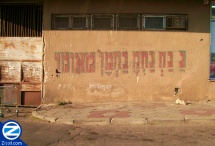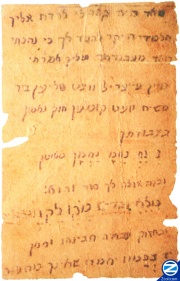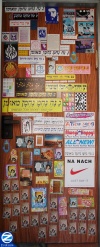Na Nach Nachma Nachman Meuman
Na Nach Nachma Nachman Meuman is a Hebrew phrase sung and spread by members of the Na Nach movement, a fringe group of Breslev Hasidim. It is based on the first name of Rebbe Nachman of Breslov along with Uman, the city where he is buried. According to the Nanachs this was how Rebbe Nachman signed his name in the Petek, a letter he sent Rabbi Yisroel Ber Odesser 122 after his death.
Nanachs consider the phrase 'Na Nach Nachma Nachman Meuman' to be 'The Song of Redemption' mentioned in the Kabbalah. In recent years the phrase Na Nach Nachma Nachman Muman has received a lot of publicity. Due to the efforts of the Nanachs it has been spread all over Israel, appearing in stickers, billboards, signs and a lot of graffiti.
Contents |
[edit] Yisroel Dov Ber Odesser
One of the first Breslev Hasidim to live in Israel, Yisroel Ber Odesser joined the group while still a teenager living in Tiberius. Breslev at the time was considered a very controversial group amongst religious Jews and Odesser suffered greatly for identifying with it. At age 33 Odesser claims to have received a letter from Rebbe Nachman of Breslov, who had passed away many years before. This letter that eventually became known as 'the Petek', was kept in secrecy by Odesser for many years. It was only in his old age that Odesser gathered followers around him and began spreading the Petek and the phrase Na Nach Nachma Nachman Meuman.
[edit] The Petek
During the summer of 1922, Odesser felt very ill on the 17th of Tamuz and broke the fast. Odesser considered this a serious offense against his Avodas Hashem. His transgression caused him to fall into a severe six day depression. During this time he did not eat or drink and did almost nothing but lay on a bench and pray. On the sixth day of his depression a powerful thought entered Odesser's mind instructing him to approach his bookcase and open a book. Yisroel Ber Odesser opened up a Likutay Halochos Aurach Chaim part 1 and an aged piece of paper fell out of the book. Assuming the paper to be an old bookmark, Odesser ignored it at first but soon realized it was a letter from Rebbe Nachman of Breslov addressed directly to him.
Although Rebbe Nachman of Breslov had passed away in 1810, 112 years earlier, Odesser accepted the Petek with simple faith believing it to be a letter from heaven. On the surface, the Petek appears to be nothing more but a letter of encouragement to Yisroel Odesser. According to Odesser and his followers the Petek contains much deeper messages then what is assumed with a superficial glance.
![]() Read full Zissil article on the Petek
Read full Zissil article on the Petek
[edit] Content of the Petek
| Very hard it was for me to descend to you
My precious student to tell you that I benefited Greatly from your service and upon you I said My fire will burn until Messiah will come be strong and brave In your service Na Nach Nachma Nachman Me'Uman And with this I shall reveal to you a secret and it is: Full and heaped up from line to line (PZPZYH) And with strong service you will understand it and the sign is The 17th of Tammuz they will say that you are not fasting |
מאד היה קשה לי לרדת אליך
תלמידי היקר להגיד לך כי נהנתי מאד מעבודתך ועליך אמרתי מיין פיירעיל וועט טליען ביז משיח וועט קומען חזק ואמץ בעבודתך נ נח נחמ נחמן מאומן ובזה אגלה לך סוד והוא מלא וגדיש מקו לקו (פצפציק) ובחזוק עבודה תבינהו וסמן יז בתמוז יאמרו שאינך מתענה |
[edit] Song of Redemption
On the seventh line of the Petek, Rabbi Nachman of Breslov signs his name; Na Nach Nachma Nachman Meuman. According to Rabbi Odesser and the Nanachs this is far more then an usual signature, it is a revelation of the legendary 'Song of Redemption'.
Rebbe Nachman mentions the 'Song of Redemption' in Likutay Maharan 2, Torah 8. This was the last Torah that Rebbe Nachman gave over. It was given on Rosh Hashanah, two weeks before he passed away and is considered by some Breslovers to be his last will and testament. Rebbe Nason wrote extensively about the Shir Hageula throughout Likutay Halochos, dedicating an unusual amount of coverage to this topic.
[edit] The Ten Songs
According to early Kabbalistic sources such as the Tikunay Zohar and Targum Yonason there were ten songs that were destined to be revealed throughout the history of the Jewish Nation. These include the Song of the Sea (Az Yashir), the Song of the Well and the Song of Songs. To this point in time, nine out of the ten songs have been revealed and have served their role in history. What remains is the 'Song of Redemption'. Tradition teaches that this last song will be revealed during the time of the final redemption. Through this song, true faith in Hashem will be restored in the world and Moshiach will lead the Jews out of exile.
[edit] The Achoraim Formula
In the Tikunay Zohar it clearly states that the 'Song of Redemption' will be Y - YH - YHV -YHVH. This is the the Shem Havaya (Tetragrammaton / YHVH) written in the Achorayim formula. Many Kabbalistic texts make use of the Achoraim formula for various meditations and gimatriyas. Achoraim literally means backwards and is given this name since before adding a new letter you go back and list the old ones. When the Achoraim formula is used with a four letter word it is called Ribua, literally quadrupled, since that is being done to the letters.
[edit] The Name of the Tzadik
Pronouncing the Tetragrammaton in any form or shape is clearly forbidden by Halacha. This would also apply to the 'Song of Redemption' as it is brought down in the Tikunay Zohar. Na Nachs claim that until Moshiach comes and people become pure enough to pronounce the Tetragrammaton, the name Na Nach Nachma Nachman Meuman may be used in its place. This statment is disputed by all other Jewish groups, especially traditional Breslov Hasidim.
There are a number of sources in traditional Judaism that speak about the benefits of mentioning a Tzadik's name. According to the Kabbalah the entire essence of a person is alluded to in his name. When someone mentions the name of a Tzadik he awakens all the good deeds and Avodas Hashem that this person did in his life. In Sefer Hamedos, Rebbe Nachman of Breslov writes that the laws of nature can be changed by reciting the names of the righteous.
According to most Breslev Hasidim, Rebbe Nachman was the greatest Tzadik to ever live. Na Nachs quote the Likutay Maharan where it says the name of the true Tzadik is dressed and joined with the name of Hashem. It also says that when the name of the Tzadik is glorified, Hashem's name also becomes glorified. Rabbi Yisroel Ber Odesser claimed; the Petek revealed to him that the name of Hashem can temporarily be replaced with the name of the Tzadik and used for the 'Song of Redemption'.
[edit] Na Nach Nachma Nachman Muman
Rabbi Yisroel Ber Odesser taught that simply reciting the name Na Nach Nachma Nachman Meuman can bring about salvation. He recommended that it be chanted by any person undergoing a dilemma or suffering. According to Odesser, reciting the name Na Nach Nachma Nachman Meuman has the power to keep sins away and bring a person closer to Hashem and true faith.
[edit] Pronouncing Na Nach
Na Nach Nachma Nachman Meuman contains the Hebrew letter Chet. There is no equivalent sound to the letter Chet in the English language. It is pronounced with a guttural KH sound as in German "ach" and can be read as Nah-nakh-nakhmah-nakhman-meh-oo-mahn.
- Na (One letter, Single: Nun) נ
- NaCH (Two letters, Double: Nun, Chet) נח
- NaCHMa (Three letters, Triple: Nun, Chet, Mem) נחמ
- NaCHMaN (Four letters, Quadrupled: Nun, Chet, Mem, Nun) נחמן
- Meuman (From Uman, Identifying the Nachman we are referring to.) מאומן
[edit] The Nekudos
In the actual petek, Na Nach Nachma Nachman Muman is written with Nekudos. According to Rabbi Odesser, the nekudos on the phrase Na Nach Nachma Nachman Meuman have very significant meanings. Some Nanachs consider the phrase much holier when accompanied by Nekudos and will not bring it into the bathroom when it is printed in such a form.
[edit] Power of the Song
Nanachs believe very strongly in the power of the song Na Nach Nachma Nachman Meuman and have many tales to tell how it brought them personal salvation. There are also a number of stories circulating about miracles Rabbi Odesser performed through the use of this name.
Nanachs say the song has 10 letters that parallel the 10 types of song, 10 Sefitot and 10 sayings with which the world was created. It has four parts that parallel the 4 spiritual worlds, 4 spiritual base elements and the 4 parts of the Chariot.
[edit] Sources in Breslev
In general the song Na Nach Nachma Nachman Meuman and all its deeper meanings have been completly rejected by mainstream Breslev groups. Some of them even claim that using the phrase Na Nach Nachma Nachman Meuman is a disgrace to to Rebbe Nachman's name.
[edit] Letter from Rav Getzl
There is a letter from Rav Getzl, one of the main students of Rebbe Avraham ben Nachman where he mentions the possibility of formatting Rebbe Nachman's name in Rebua; Na Nach Nachma Nachman Muman. He then goes on to give a number of Gimatriyas aligning it with the Shir Hageula.
[edit] Elders of Breslov
According to Rabbi Odesser's testimony, the Petek was accepted by a number of the Breslev Elders. These include R' Shlomo Wexler, R' Naftali Cohen, R' Nason Bitlmacher, R' Shmuel Horowitz, R' Shmuel Mair Anshin, R' Yichiel Grunwald, R' Chaim Broyd Tevrvnivsky, R' Simcha Bunim Kalshiner, R' Tvi from Bardichev, R' Moshe Shmuel, R' Avraham Yackov Goldriche, R' Ben Tzion Apter, R' Alter Benzion, R' Yitzchock Isaac Zilberman, R' Mordichi Elazar Costintiner, R' Shmuel Shapiro, R' Aryeh Shapiro, and R' Mordichi Yiglink.
[edit] Letter from Shmuel Horowitz
There is a letter from R' Shmuel Horowitz to his student R' Yitzchok that is printed in the book Zeh Yinachamanu (Shir Chadash / Yitzchok Bezenson) where he confirms that Rebbe Nachman's name is the Shir Hageula and then goes on to expand on this concept.
[edit] Shir Naim
There is a song published in the beginning of most Likutay Maharan's called the Shir Naim. This song was written by Rebbe Nachman himself. First letters of each sentence in the Shir Naim spell out the name Nachman ben Simcha. Towards the end of the song a number of the letters are doubled, tripled and quadrupled, in a way resembling but not exactly spelling out the phrase Na Nach Nachma Nachman. In the introduction to the song, Rebbe Nasson writes explicitly that Rebbe Nachman's name is listed in a Ribua format.
[edit] The Nanach Movement and Hafatza
During the last ten years of his life Rabbi Yisroel Ber Odesser gathered around him a group of followers that eventually became known as the Na Nach movement. Odesser strongly pushed the idea of Hafatza, a term used for distribution activities on the Petek and Rebbe Nachman's books. Many Nanachs dedicate their entire life to Hafatza. Spreading the song Na Nach Nachma Nachman Meuman is considered a very important goal by many Nanachs.
Nanachs are a relatively small group in Israel but have made their presence very noticeable. The song Na Nach Nachma Nachman Meuman can be found all over the country in the form of stickers, clothing, signs, and controversial Nanach graffiti. Na Nachs will often ride across Israeli cities in large vans covered with the phrase Nach Nachma Nachman Meuman, blasting loud techno music. Most Na Nachs wear large white kipas embroidered with the phrase Nach Nachma Nachman Muman. Nanach Kipas are also their number one selling product.
Another popular item amongst the group is the Nanach Kemea. A small amulet worn around the neck, the Nanach Kemea contains a copy of the Petek and the song Nach Nachma Nachman Meuman written on a piece of parchment.
![]() Read full Zissil article on Na Nach
Read full Zissil article on Na Nach



